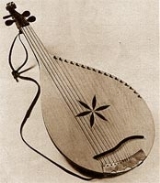
Starosvitska bandura
Encyclopedia

Culture of Ukraine
Ukrainian culture refers to the culture associated with the country of Ukraine and sometimes with ethnic Ukrainians across the globe. It contains elements of other Eastern European cultures as well as some Western European influences. Within Ukraine, there are a number of other ethnic groups with...
folk instrument of the zither
Zither
The zither is a musical string instrument, most commonly found in Slovenia, Austria, Hungary citera, northwestern Croatia, the southern regions of Germany, alpine Europe and East Asian cultures, including China...
family, common from the late 18th century.
The Starosvitska bandura is also referred to as "Classical", "authentic" or "old-time" bandura.
These instruments usually have some 12-20-23 strings, tuned diatonically (4-6 bass strings and 16-18 treble strings known as prystrunky
Prystrunky
Prystrunky - term used for the additional strings strung across the body of Ukrainian folk instruments such as the kobza, bandura and torban. Literally meaning "Near the strings". These additional strings are thought to have appeared on these instruments in the 17th century. On the contemporary...
). These instruments are hand-made, usually by local village violin makers with no two instruments being identical. The backs are usually hewn out of a single piece of wood, usually willow, and wooden pegs made of hard woods. The strings are tuned to a diatonic scale (major, minor, or modal) with bass strings tuned to corresponding I, IV, and V degrees of the diatonic row.
Traditionally these instruments had gut strings, however, after 1891 with the introduction of mass-produced violin strings steel strings began to become popular and by the beginning of the 20th century they were prevalent.
It is suggested that the instrument developed as a hybrid of gusli (Eastern-European psaltery) and kobza
Kobza
The kobza is a Ukrainian folk music instrument of the lute family , a relative of the Central European mandora...
(Eastern-European lute) and although the term bandura can date itself to Polish chronicles from 1441, this hybridization occurred in the late 18th or early 19th centuries.
The instrument was used almost exclusively by itinerant blind epic singers in Ukraine, called kobzar
Kobzar
A Kobzar was an itinerant Ukrainian bard who sang to his own accompaniment.-Tradition:Kobzars were often blind, and became predominantly so by the 1800s...
i.
In recent times there has been a movement of renewed interest in playing the authentic folk version of the bandura initiated by the students of Heorhy Tkachenko
Heorhy Tkachenko
Heorhiy Kyrylovych Tkachenko .-Biography:Tkachenko was able to complete his high school education in Kharkiv before continuing his education in Moscow. He completed his education in Moscow as an architect in 1929 and continued to live in Moscow where he designed many of the parks around the city...
in the 1980s. Formal courses have been designed for the instrument as have been written handbooks. A category for authentic bandura playing has been included in the Hnat Khotkevych
Hnat Khotkevych
Hnat Martynovych Khotkevych December 31, 1877 in Kharkiv, Russian Empire – October 8, 1938 in Kharkiv, in the Ukrainian SSR of the Soviet Union) was a Ukrainian writer, ethnographer, playwright, composer, musicologist, and bandurist....
International Folk Instruments competition held in Kharkiv
Kharkiv
Kharkiv or Kharkov is the second-largest city in Ukraine.The city was founded in 1654 and was a major centre of Ukrainian culture in the Russian Empire. Kharkiv became the first city in Ukraine where the Ukrainian Soviet Socialist Republic was proclaimed in December 1917 and Soviet government was...
every 3 years.

